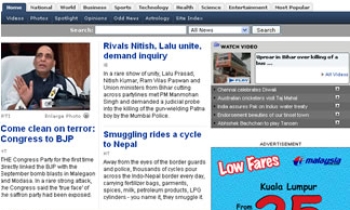What exactly is Alan Rusbridger trying to do with the Guardian, or "theguardian", as its masthead has it? On Monday, readers had their first sight of the new Berliner format, which is a shrunken broadsheet or a puffed-up tabloid, depending on how you look at it. But the biggest interest, for many, will be in how, if at all, Rusbridger changes the editorial content.
The Times (of which more later) has moved downmarket while the Independent has become a "viewspaper", splashing its reporters' indignation about Iraq, global warming, world poverty and the plight of great apes across its front page. As Rusbridger sees it (I paraphrase what he has said to me and others), this allows the Guardian to establish itself clearly as an upmarket paper which, though still "of the left", gives you the news straight. It will, he intends, be a broader church, breaking free of its left-wing niche.
This is easier said than done. A smart-alec, superior tone, characteristic of metropolitan lefties, runs deep through the Guardian, influencing even headlines and captions. Its commentators are apt to write: "How should we regard this Tory contest? Do we want the worst candidate to win?" (Jackie Ashley, 25 August). Rusbridger, if he is to stamp out this sort of thing, will need to achieve a significant cultural change.
I wonder how far he will go. For example, when exam results come out, Guardian reporters seek comment from the Campaign for State Education, Daily Telegraph reporters from the Campaign for Real Education. A "research study" showing the economic benefits of immigration will be highlighted in the Guardian; one showing, say, what migrants take from the welfare state will be big in the Telegraph. Neither will look too closely at the provenance of the research. True, reporting can be accurate without necessarily being balanced. But "reliable and trustworthy" news (Rusbridger's words) is a more elusive commodity than most journalists admit.
And do readers want it? In its Berliner format, the Guardian is making a more definite statement of upmarket intentions than any national paper since the Independent launched in 1986. The influences are both Continental and American and, despite the big pictures and colour on every page, it has the weaknesses of serious papers in both those markets, which do not face anything like the competitive pressures of the British market. The design is handsome and the Egyptian font admirably clear but the overall effect seems to me too quiet.
Six-column pages throughout and a weak headline face that lacks bolder variations threaten to make the paper appear monotonous and lacking in urgency. The feel is more of a reflective, weekly magazine than of a rough-edged newspaper that came tumbling off the presses a few hours ago. On the first two days of the new design, this effect was compounded by headline writers who seemed, particularly in the front-page leads, to have lost active verbs from their vocabularies. "Doubts over value of £3bn Sure Start. Flagship government scheme . . . may be failing" (Tuesday's lead) promises trustworthy journalism, but you might reasonably decide that you'll wait until the Guardian has something more definite to report.
By Wednesday, however, the verbs were back, and Guardian staff will continue to get better at handling the new format. Rusbridger also has the comfort of loyal core readers who would need to be taken out and shot to stop them buying the paper. And he no doubt has reams of market research showing that readers want a calm, reliable, classy-looking paper and that they can't abide hysterical black headlines about celebrities, soaps and scandal. He has taken them at their word. I wish him luck.
Meanwhile, if Rusbridger wants to occupy upmarket territory, the Times has further cleared the way for him by redesigning its second section, now called "times2". This section has a troubled history and has never established the brand identity of the Guardian's g2, formerly G2 (you will by now have gathered that upper case is uncool). It is now being marketed as a section to attract women, a move that caused the Mail to announce itself as "the paper that smart women choose".
Smart or not, the Mail certainly pitches to more intelligent women. To judge by the new design, the Times believes women suffer from poor eyesight and short attention spans, as well as small brains. For the main pieces, the type is almost absurdly large and some pages look as if they come from a Janet and John learner. The theme for the first week was love and sex (well, that's all women are interested in, isn't it?), complete with those old features editor's standbys, "a revealing new poll" and an article by Fay Weldon.
The future of British journalism may depend on whether times2 or the Berliner Guardian proves more successful. We must all, therefore, support Rusbridger to the hilt, by purchasing two copies each of his paper if necessary. (Interest declared: I am an occasional Guardian contributor, and he may then pay me higher fees.)









